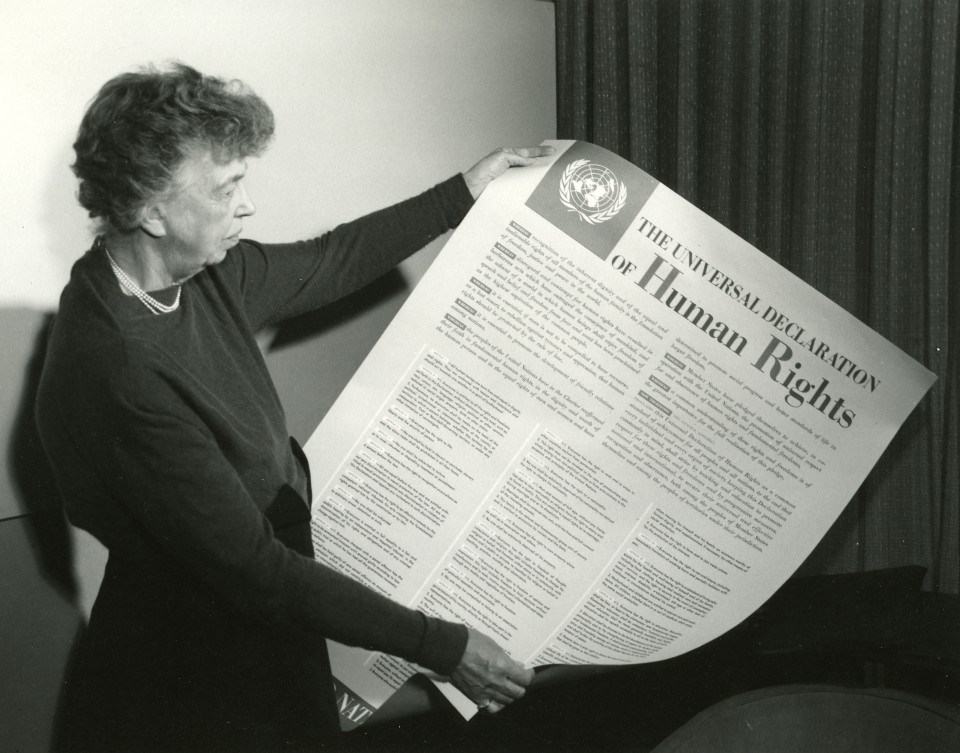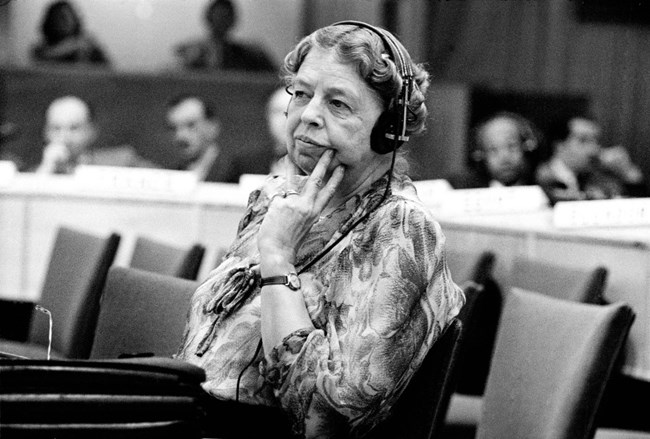
FDR Library Photo April 25, 1945, representatives from fifty nations convened in San Francisco to organize the United Nations. Over the course of nine weeks, the delegates debated what the scope and the structure of this new body should be. June 26, they adopted the United Nations Charter, Article 68 of which mandated that the General Assembly “set up commissions in economic and social fields and for the promotion of human rights.” In February 1946, following the opening session of the General Assembly, the United Nations Economic and Social Council (ECOSOC) established a nine-member “nuclear” commission on human rights to recommend a structure and mission for the permanent Human Rights Commission (HRC). Unlike other commissions, however, the delegates appointed to this nuclear body would be chosen for their individual merits rather than their national affiliation. President Harry Truman had appointed Eleanor Roosevelt to the United States delegation to the United Nations in December 1945. Soon after her return the following February from London, where the General Assembly first convened, she received a call from UN Secretary-General Trygve Lie, telling her that he had appointed her to the nuclear commission charged with creating the formal human rights commission. April 29, 1946, at New York’s Hunter College, Henri Laugier, the assistant secretary-general for social affairs, called the first session of the nuclear commission to order. Laugier hoped the delegates would remember that “the free peoples” and “all of the people liberated from slavery, put in you their confidence and their hope, so that everywhere the authority of these rights, respect of which is the essential condition of the dignity of the person, be respected.” Their work “would start [the UN] on the road which the Charter set for it.” He concluded: You will have before you the difficult but essential problem to define the violation of human rights within a nation, which would constitute a menace to the security and peace of the world and the existence of which is sufficient to put in movement the mechanism of the United Nations for peace and security. You will have to suggest the establishment of machinery of observation which will find and denounce the violations of the rights of man all over the world. Let us remember that if this machinery had existed a few years ago . . . the human community would have been able to stop those who started the war at the moment when they were still weak and the world catastrophe would have been avoided. As soon as Laugier finished his remarks, Dr. C. L. Hsia, from China, nominated ER to chair the commission. All the delegates promptly endorsed his recommendation. ER, who did not anticipate this responsibility, promised to “do my best, although my knowledge of parliamentary law is somewhat limited.” She recognized “that we are all conscious of the great responsibility which rests upon us . . . . to help the United Nations achieve its primary objective of keeping the peace of the world by helping human beings to live together happily and contentedly.”1 Once the “nuclear” commission agreed on the structure the permanent commission should adopt, it adjourned. ECOSOC had presented the HRC with three tasks: “a draft International Declaration, a draft covenant, and provisions for the implementation.” This was not easy work. It challenged the Commission to craft a vision, develop legally binding protocols acceptable to all member states, and structure an International Court of Human Rights. Political discord surfaced immediately, both within the Commission itself and within the American delegation. When the permanent Human Rights Commission convened in the fall of 1946, it promptly elected ER as its chair. For the next two years, ER dedicated most of her energy to commission duties. This required fierce patience and determination. 
United Nations Photo Cold war politics frequently threatened to derail first, the drafting process, and then, the adoption itself. As the HRC debated what the three human rights protocols should contain—and when the HRC should instruct the UN to act to protect the human rights of a nation’s citizens—hyperbole erupted. American conservatives charged any human rights document crafted by the United Nations would bring socialism to America while delegates from the Soviet bloc argued that racial segregation proved that the western democracies gave only lip service to civil and political rights. Concerns regarding national sovereignty, real or imagined, also threatened to destroy the HRC’s work. ER responded to these fears by urging the HRC to reorder its plan of work. Rather than focus on crafting a legally binding International Bill of Rights, the HRC should work on all three ECOSOC tasks simultaneously. The delegates agreed and created subcommittees for each task. They then appointed ER to chair the subcommittee charged with drafting the Declaration. Throughout these often exhaustive debates, ER strove to remind the HRC, and ultimately the UN itself, that the Declaration must serve as a counterforce to the fear and horror exposed by World War II. She insisted that the Declaration be written in clear accessible language so that it might be readily embraced by peoples of the world. She exerted similar pressure on the U.S. State Department, arguing that for the declaration to have any impact it must not be seen as an American or western dominated document. In the process, she played the key role in convincing the State Department to expand its concept of human rights from a concept of merely political and civil rights to include economic, social, and cultural rights. For ER, her work with the HRC provided the opportunity to address issues she championed as First Lady (poverty alleviation, access to education, conflict resolution, and civil rights) as well as the issues she addressed as a delegate to the General Assembly (refugee concerns, humanitarian relief, and the reconstruction of war-torn Europe). She saw this as real political work rather than a mere intellectual exercise. “Many of us thought that lack of standards for human rights the world over was one of the greatest causes of friction among the nations,” she told readers of Foreign Affairs, “and that recognition of human rights might become one of the cornerstones on which peace could eventually be based.” She viewed the crafting of the declaration as “a very grave responsibility.” The peoples of the world, many of whose lives seemed to teeter between hope and fear, “look upon us, regardless of the governments we spring from, as their representatives, the representatives of the peoples of the world, and for that reason, I hope that every one of us is going to feel, in the consideration of the question of how we constitute the full Commission and of how we recommend that the work shall be undertaken.”2 Though not legally binding, ER thought the declaration could push the world away from war. If it could establish “basic standards” which would guide the United Nations in “promoting and encouraging respect for human rights and fundamental freedoms for all,” it would have the ”moral” force necessary to “guide and [inspire] individuals and groups throughout the world . . . to promote respect for human rights.” Responding to a wave of pressure from President Truman and Secretary of State George C. Marshall to launch a moral offensive against the USSR, she agreed to deliver a keynote address at the Sorbonne in Paris in September 1948. She titled her remarks, “The Struggle for Human Rights.” By the time ER assumed the podium that fall, domestic politics and international tensions combined forces to hinder the Declaration’s adoption. The subcommittee had distributed its draft of the Declaration (which the Soviet bloc had not endorsed) for member nations’ review in the spring. Over the summer, the Soviets blockaded Berlin, communist-supported unions struck in Italy and France, the Arab-Israeli conflict escalated, Mao tse Tung battled nationalist forces in China, and American political parties splintered.Calling “the preservation of human freedom” “one of the greatest issues of our time,” ER told the overflow audience the world still struggled to rebound from the violence and coercion of wartime totalitarian governments and that only the Declaration had the “moral force” to shift the discussion away from the “reaction, retreat, and retrogression” of the past.” The world must take the time “to think carefully and clearly on the subject of human rights, because in the acceptance and observance of these rights lies the root, I believe, of our chance for peace in the future, and for the strengthening of the United Nations organization to the point where it can maintain peace in the future.”3 ER’s address at the Sorbonne set the tone for the forthcoming deliberations on the drafting of the declaration. The drafting process involved eighty-five working sessions (many lasting until well past midnight) in which new delegates revisited each word of the Declaration’s thirty articles. Discussions over the right to education, to an adequate standard of living, and to old-age pensions ran late into 1948, making ER worry that the committee might not act in time to have the declaration approved by the General Assembly. She discussed these deliberations so frequently in “My Day” that her column became both a primer on human rights and a sustained call for endorsement. Indeed, she became so outspoken in her advocacy that her column took on a bluntness she rarely displayed. Increasingly frustrated with Soviet delaying tactics, she made her grievances public, telling her readers, “One would admire Soviet persistence in sticking to their point if it were not for the fact that so often the point is not worth sticking to.”4 ER drove the committee hard. December 9, ER confided to her aunt: [T]he Arabs & Soviets may balk—the Arabs for religious reasons, the Soviets for political ones. We will have trouble at home for it can’t be a U.S. document & get by with 58 nations & at home that is hard to understand. On the whole I think it is good as a declaration of rights to which all men may aspire & which we should try to achieve. It has no legal value but should carry moral weight.5 The General Assembly adopted the Declaration the following day. Endnotes 1 HRC, Nuclear Commission, 1st Meeting, Summary Record, 29 April 1946, (E/HR/6/1 May 1946), 1-3, Franklin D. Roosevelt Library. 2 Eleanor Roosevelt, “The Promise of Human Rights,” by Eleanor Roosevelt, Foreign Affairs, April, 1948, in Allida Black, Courage in a Dangerous World: The Political Writings of Eleanor Roosevelt (New York: Columbia University Press, 1999), 156-168. 3 Eleanor Roosevelt, “The Struggle for Human Rights” Speech at the Sorbonne, Paris, September 28, 1948, in Allida Black, The Eleanor Roosevelt Papers: Vol. 1: The Human Rights Years, 1945-1948, 900-905. 4 Eleanor Roosevelt, My Day, December 4, 1948 in Allida Black, The Eleanor Roosevelt Papers: Vol. 1: The Human Rights Years, 1945-1948, 962-963. 5 Eleanor Roosevelt to Maude Gray, December 9, 1948, Franklin D. Roosevelt Library. This article was prepared by Allida Black, the Eleanor Roosevelt Papers Project at George Washington University for the National Park Service. |
Last updated: June 25, 2020
